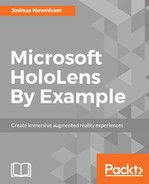It's been a while since we talked about the specifics for the example of this chapter, so let's quickly revise what we are trying to achieve before jumping to the project.
HoloLens includes a world-facing camera color mounted on the front of the device, which enables apps to see what the user sees. The example for this chapter is to create an application that captures what the user sees (the frames from this camera) and uses Microsoft's Cognitive Service Face API that we just set up to detect and identify faces. When a face is recognized, we will display their name along with a predicted age and gender. This example was based on the Microsoft's Holographic face tracking sample, which is available at https://github.com/Microsoft/Windows-universal-samples/tree/master/Samples/HolographicFaceTracking.
Let's start by launching the starter solution for this chapter; this can be found in the Chapter2Starter directory from the https://github.com/PacktPublishing/Microsoft-HoloLens-By-Example repository. Launch the Visual Studio solution by either double-clicking on the FaceTag.sln solution file or by loading from within Visual Studio by clicking on File | Open | Project/Solution and navigating to, and selecting the FaceTag.sln file. The starter solution is the standard Visual C# Holographic DirectX 11 App Template we created in the previous section, with the addition of some classes and shaders used to analyze the frame used by the Face API Cognitive service we set up earlier and also used to render the results. Including this in the starter will allow us to focus on HoloLens-specific code, such as capturing the HoloLens frames and positioning the label in the scene (and keep this chapter at a reasonable length).
